Knanaya
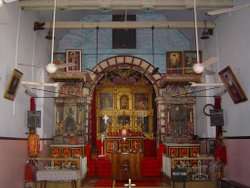 St. Mary's Knanaya Jacobite Church in Kottayam | |
| Regions with significant populations | |
|---|---|
| c. 300,000 (Kerala, India; Chicago; elsewhere) | |
| Languages | |
|
Malayalam; local languages Liturgical: Syriac | |
| Religion | |
| Predominantly Syro-Malabar Catholic Church and Malankara Jacobite Syrian Orthodox Church | |
| Related ethnic groups | |
| Saint Thomas Christians, Malayalis, Cochin Jews |
The Knanaya, also known as the Southists or Tekkumbhagar, are an endogamous group in the Saint Thomas Christian community of Kerala, India. They are differentiated from another part of the community, known in this context as the Northists. Today there are about 300,000 Knanaya in India and elsewhere.[1]
The origins of the division of the Saint Thomas Christians into Northist and Southist groups are unclear. Various traditions trace it back to the arrival of the Syrian merchant Thomas of Cana in the 4th or 8th century, while another legend traces their origin to Jews in the Middle East. The divisions were present by the time of the Portuguese colonization in the 16th century, and were noted through the European colonial era.
Today the majority of Knanaya are members of the Syro-Malabar Catholic Church and the Malankara Churches. They became increasingly prominent in Kerala in the late 19th century. Many Knanaya migrated away during the 20th and 21st centuries, largely westward, forming communities in non-Malayalam speaking areas, with a large expatriate community currently living in Chicago, Illinois, United States.
Names

The term Knanaya derives from the name Thomas of Cana, an important figure in Saint Thomas Christian tradition. The ultimate derivation of Thomas' epithet Cana is not clear: it may refer to the town of Cana, which is mentioned in the Bible, or it may instead refer to the land of Canaan.[2] Alternately, it may be a corruption of a Syriac term for merchant (Knāyil in Malayalam).[3] However, scholar Richard M. Swiderski states that none of these etymologies are entirely sound.[2] Knanaya priest and scholar Jacob Kollaparambil argues that the "Cana" form is a corruption introduced by European scholars based on the Malayalam form Knāy and its variants (Kynāi, Kināyi, Kinān) found in the folk tradition of the Knanaya and the common parlance and literature of the people of Malabar.[4] This may be a reference to the Christian community of Kynai, in Bét Aramayé in Persia.[5] Knanaya is the spelling preferred by community members; other less common spellings include Cananites and Cnanites.[2]
The Knanaya are also known as Tekkumbhagar in Malayalam; this is generally translated into English as "Southist", or sometimes "Southerner" or "Suddhist". This is in reference to the historically significant geographical division between them and other Saint Thomas Christians, who are known as Vadakumbhagar or Northists in this context.[6]
History
Origins and traditions
It is not clear how the division of the Saint Thomas Christians into Southern and Northern groups originated. The earliest written evidence for the split dates to the 16th century.[7] Directional divisions within communities are common in Kerala, including among Hindu groups.[8][9] A similar north-south division is found among the Nairs, and it historically appears to have been in place in the early Brahmin settlements in the area. The Saint Thomas Christians may have taken this trait from the Brahmins.[8]
A number of traditions and stories have emerged to explain the division,[10] and both Southists and Northists use variants of these traditions to claim superiority for their group.[11] The earlier version traces the divide to the figure of Thomas of Cana, a Syrian merchant who led a group of 72 immigrant families from the Middle East to settle in India in the 4th century (some sources place these events in the 8th century).[11] This story may reflect a historical migration of East Syrian Christians to India around this time, which established the region's relationship with the Church of the East.[12] In the Knanaya versions of this story, the Knanaya are the descendants of Thomas of Cana and his followers, while the Northists descend from the local Christian body which had been converted by Thomas the Apostle centuries earlier.[13][14] Elements of the Thomas of Cana story feature in ancient songs as well as a copper plate grant awarded to Thomas of Cana followers by a local ruler.[15][16][17] These plates are said to have granted Thomas's followers 72 "privileges" from Cheraman Perumal, the Chera king.[18] The plates were present in Kerala during the time of the Portuguese colonization in the early 17th century, but were lost during Portuguese rule.[19] The Knanaya invoke the plates as evidence of their descent from Thomas of Cana's mission.[20]
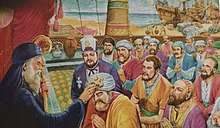
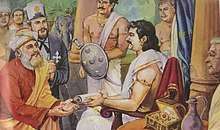

In many other variants, Thomas of Cana had two wives or partners, one of them being the ancestor of the endogamous Southists, and the other one being the ancestor of the Northists.[8][14] In some of these variants, the Southists' ancestor was Thomas' Syrian wife, while the Northists' was an indigenous Nair woman who became his second wife or concubine, implying that the Southists are Thomas' true heirs.[21] In other variants, both wives were Kerala natives, while the Southists' forebearer was from a higher caste.[22] More recent versions of this story downplay the importance of either wife's status, focusing instead on their descendants' marriage practices: the Northists intermarried with the natives, while the Knanaya enforced strict endogamy, maintaining a "pure" lineage.[23]
Northists also maintain versions of the Thomas of Cana story that counter the Knanayas' assertions. In the Northist versions, both Northists and Southists are descended from marriages between Thomas' party and indigenous Christians, but the Knanaya are descended from Syrian servants who married "low caste" Keralans; the Knanayas' endogamy and "purity" are thus borne out of their exclusion by the higher class Northists. These variants frequently trace Knanaya descent back to a dobi (washerwoman); in some versions of this story, she became Thomas' concubine, while in other she married a lower-caste Maaran boy.[24] This assertion is based on the 1676 Portuguese document "M.S Sloane 2748-A", a likely forgery attributed to the Carmelite priest Father Mathew.[25]
Another story regarding the origin of the division became popular during the 20th century. In 1939, Knanaya politician and author Joseph Chazhikaden published a book on the community, Tekkumbhagasamudayam Charitram, in which he argued that the Knanaya were the descendants of ancient Jews. Chazhikaden built upon Thomas of Cana tradition, but asserted that Thomas's followers originated in Judea. According to Chazhikaden, the group converted to Christianity while maintaining their distinct culture and identity.[23] Eventually they were forced out of their homeland and moved to Cranganore, where they were welcomed by the ruler Cheraman Perumal and lived near, but maintained their separateness from, the indigenous "Northist" Saint Thomas Christians. Swiderski believes that the legend was "conceived and promulgated" by Chazhikaden himself.[26] Many modern Knanaya accept the account as factual, while others reject it. As with other Knanaya origin traditions, Northists dispute and condemn it.[27]
Early mentions
The first known written evidence for a division in the Saint Thomas Christian community dates to the 16th century, when Portuguese colonial officials took notice of it.[28][29] A 1518 letter by the Jesuit missionary Alvaro Penteado mentions a conflict between the children of Thomas of Cana, hinting at a rift in the community in contemporary times.[28] In 1525, Mar Jacob, a Chaldean bishop in India, recorded a battle the year before that destroyed Cranganore and many Knanaya homes and churches.[30][31] The event is noted in the Knanaya folk song "Ennu Nee Gnangle Kaiviitto Marane" or "Have You Forgotten Us Today Oh Lord?"[31][32].
In 1579 the Jesuit missionary Monserrate wrote on the tradition of Thomas of Cana's two wives for the first time; he describes the division of the community, but gives no details about either side.[33][34] A 1603 letter by Portuguese official J. M. Campori further discusses the division, which had by that point become intermittently violent; he gives multiple versions of the story of Thomas' two wives.[35][14][36] In 1611, chronicler Diogo de Couto was the first to mention the tradition that a contingent of families had accompanied Thomas of Cana.[37][14] Other Portuguese authors who wrote of the Southist-Northist divide, generally referencing versions of the Thomas of Cana story, include the envoy Antonio de Gouvea (1602–1603),[38][14] Archbishop Francis Ros (1604),[39][14] Franciscan friar Paulo da Trinidade (1630–1636),[40] and Bishop Giuseppe Maria Sebastiani (1657).[14][41]
Following the Coonan Cross Oath of 1653, both the Southists and Northists were split internally into Catholic and Malankara Church factions; this rift overshadowed the north-south divide for a period of time. European observers tended to label the Northists and Southists as "castes", and regarded them as examples of the prevalence of divisions in Indian society in general.[42] Later, both Saint Thomas Christians and Europeans tried to assuage the animosity and downplay the division.[43]
Modern era
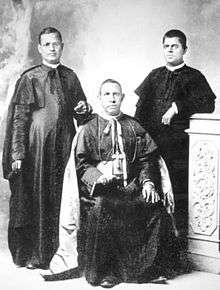
In the late 19th century social changes in British India led to increased wealth and social power for the Saint Thomas Christians. This social change tended to advance internal divisions within the community, including the Southist-Northist division.[44] Through this period the Knanaya promoted their own uniqueness and independent identity to push for further opportunities for their community. They sought the establishment of Knanaya-centred parishes for both the Malankara and Catholic churches, which were founded in 1910 and 1911, respectively.[44]
Like other Saint Thomas Christians, many Knanaya have migrated away from Kerala and India since the 20th century. The largest Knanaya diaspora community is located in Chicago.[45] This community originated in the 1950s when a small number of Knanaya and other Kerala natives emigrated to the area as university students; they were followed by more substantial immigration after 1965. The immigrants met up periodically for social events, and in the 1970s organizations for Catholics, members of other Christian churches, and Hindus were formed. In the 1980s the various Indian Catholic particular churches sent chaplains to Chicago; in 1983 the Bishop of Kottayam sent a chaplain to minister specifically to the Knanaya Catholics.[46]
Religious traditions
Traditionally the Knanaya have followed the religious traditions and practices of the wider Saint Thomas Christian community. In the 17th century, when the Saint Thomas Christians were split into Catholic and Malankara Church factions following the Coonan Cross Oath, both the Knanaya and Northist groups were internally divided.[47] The Malankara faction became affiliated with the Syriac Orthodox Church, an Oriental Orthodox church based in Syria, while the Catholic faction is now known as the Syro-Malabar Catholic Church. Beginning in the late 19th century, both Malankara and Catholic Knanaya lobbied for their own dioceses within their respective denominations. In 1910, the Syriac Orthodox Church established a distinct Knanaya-oriented diocese in Chingavanam, which reports directly to the Patriarch of Antioch. The following year, the Catholic Church established a Knanaya Catholic eparchy (diocese) in Kottayam, known as the Syro-Malabar Catholic Archeparchy of Kottayam.[48]
Culture
Like other Saint Thomas Christians, Southist culture is largely derived from Syriac Christian culture mixed with local Indian customs, with later elements derived from Indian and European contacts. A number of scholars have found that the traditions and customs of the Knanaya are similar to those of the Cochin Jews of Kerala. This can be seen through the similarity in folk songs and folk traditions. This symmetry likely resulted from the fact that the groups have lived in close proximity for centuries, and may also reflect the Knanaya's claimed Judeo-Christian ancestry.[49]
Folk songs
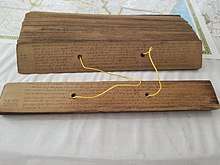
Knanaya folk songs are ancient in origins and were first written down in the year 1910 by the Knanaya scholar P.U Luke in his text Puratana Pattukal, or Ancient Songs.[50][51][52] The origins of the songs themselves are unknown but were collected by Luke from Knanaya families who kept palm leaf relics which contained the text of these songs. [53] The songs were written in Old Malayalam but contain diction and lexemes from Sanskirt, Syriac, and Tamil indicating their antiquity.[54] Analytically, these ancient songs contain folklore about the faith, customs and practices of the community, narratives of historical events (such as the mission of St. Thomas the Apostle and the immigration of the Knanaya to India), biblical stories, songs of churches, and the lives of saints.[50] Scholars have also found that the songs of the Knanaya are of a similar composure, linguistics, and characteristic to that of the Cochin Jews and that some songs even have almost the same lyrics with the exception of a few words or stanzas. According to the Cochin Jewish scholar P. M. Jussay, "these similarities are not accidental and cannot be easily explained".[49][55]
Knanaya "Kulli Pattu" or Bath Song:
"Ponnum methiyadimel melle melle avan natannu
(With golden shoes he slowly walked)
Velli methiyadimel melle melle aval natannu"
(With silver shoes she slowly walked)[56]
Cochin Jewish procession song:
"Ponnum methiyadimel melle natannan, Chiriyanandan,
(With golden shoes Chiriyanandan (Joseph Rabban) slowly walked)
Velli methiyadimel melle natannan, Chiriyanandan"
(With silver shoes Chiriyanandan (Joseph Rabban) slowly walked)[56]
Some songs show the influence of the Hindu culture of Kerala. For instance, the Knanaya song Mailanjipattu is adapted from the Hindu song Krishnagatha.[57]
Folk traditions
After the burning of Craganore during one of the many battles of the Zamorin of Calicut, the homes and temples of both the Cochin Jews and Knanaya were destroyed. In order to remember what was lost, the Cochin Jews carry a handful of earth from the hallowed spot where their synagogues once stood, to be used in traditions such as depositing onto the graves of deceased relatives. Likewise, the Knanaya also carried a handful of charred earth as a keepsake from the place of their settlement. From this act originated the custom of them taking a pinch of ash from the hearth of the ancestral home of the new bride, and depositing it in a knot at one end of her new dress when she bade farewell to it and went to live with her husband in their new house. On account of this, the Northist Christians dub them derisively as "Charam kettikal", or knot makers of ash.[31]
The burning of Craganore from where this tradition developed, was a vital and drastic event for both the communities and sheds light on the folk tradition of maintaining legend and history through the use of song.[32]
Other folk traditions that both the Knanaya and Cochin Jews share is a common culture based upon figures and stories of the Old Testament. One of the most striking similarities is the importance given by both the communities to Joseph of the Old Testament whom the Knanaya give reverence to in the song and ancient round dance known as "Poorva Yousepintae Vattakali" or The Round Dance of Old Joseph. The Cochin Jews's also maintain traditions and songs of Joseph that esteem and glorify him as an ideal son, father, and ruler.[58] It is also a commonality of these two groups to give a local flavor to their songs, traditions, and stories of the Old Testament. In a Knanaya folk song about the biblical figure Tobias, his wedding is described to have all the paraphernalia found at a historical Christian wedding in Kerala such as "Trays of beetal leaves, bowls of sandal paste, gingerly oil, coconut oil, etc". In correlation, in a Cochin Jew folk song of about Joseph, it is described that when the biblical figure of Ruth goes to meet her lover Boaz, she is washed, well groomed, and clad in white, exactly like a Malayalee girl and Cochin Jew bride. In this way the Jews and the Knanaya make the stories of the bible not something of far away and long ago but of the immediate present and of the neighborhood.[59]
Passover traditions
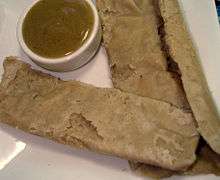
The tradition of Passover or "Pesaha" is practiced every Holy Thursday in the homes of the Knanaya. On the night of Holy Thursday the "Pesaha Appam" or Pesaha bread is made with unleavened flour along with a sweet drink made of milk and jaggery known as "Pesaha Pal" (in some families banana is also a part of this custom). The first batch of Pesaha appam is decorated and blessed with palm leaves from Palm Sunday set in the shape of a cross, the Pesaha milk also shares this adornment. The first batch is said to be the most sacred and is only given to members of the family and other Syrian Christians. In ritualistic practice, the family gathers in the home and the father or grandfather of the household blesses and prays over the bread and milk, often also reading a bible passage. He then cuts,portions and distributes the bread, banana, and milk to his family members, giving it to males of the household first. Traditionally after the celebration is over any waste product that was used in the ritual was burned away according to the rules of Leviticus and the sacred nature of the practice. It should also be noted that all utensils and vessels used in the process are either brand new or washed in a ceremonial manner. Pesaha is also regularly practiced in the homes of the larger St. Thomas Christian community but scope of usage can vary based on the specific denomination and region. Distinctions also occur based on the type of bread and products used and specific rituals that take place. Additionally if a family is in mourning following a death, Pesaha bread is not made at their home, but brought to them by their Syrian Christian neighbors. [60]
Wedding traditions
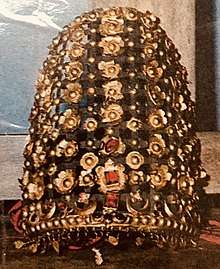
The Knanaya maintain distinctive wedding traditions and wedding customs that have helped to sustain their identity and culture. These traditions are an amalgamate of Judeo-Christian, Syriac, and Hindu customs, reflecting the Knanaya's claimed origins and the centuries that they have lived as a minority community in India. Historically, Knanaya marriage celebrations lasted several days, with many of the ceremonies centred around the home. In the present day, these ceremonies take place over three days and the wedding traditions can be divided into the categories of betrothal, groom, bride, reception, and miscellaneous. These ceremonies are also accompanied by numerous ancient songs characteristic of the Knanaya.[61]
Betrothal customs include Kaipidutham, or "clasping of hands". This is an initial agreement and fixing of the marriage, which involves the future bride and groom as well as their paternal uncles. The uncles clasp the hands of the betrothed in the presence of the priest at church. This symbolizes the uncles' and extended families', support and investment in the relationship.[62] Maternal uncles undertake a Maternal Uncles Agreement, at which they come together at the erection of the poles of the pandal, a canopy and temporary hall set up for the wedding. The uncles from each party exchange a kindy, or water bowl, for rinsing and hand washing. The dowry is also delivered by the bride's maternal uncle to the groom's uncle, and they kneel on a mat in front of a lighted lamp symbolizing Jesus, and pray as though in front of an altar.[62]
Bride and groom participate in ceremonies in their respective homes on the eve of the wedding. The groom's is Chandam Charthal, or "beautifying the boy". The village barber arrives at the pandal and requests permission to shave the groom three times. After receiving permission, the barber performs the ceremonial shaving (historically, this was his first shave), then takes him out to put oil on his head and bathe him, while the assembly sings ancient songs.[63] The bride's ceremony is Mylanchi Ideel, or "henna ceremony". The bride's palms, feet, and nails are smeared with a special yellow or green henna, by her maternal grandmother. Similar ceremonies are found among various Hindu and Muslim groups in India; the Knanaya, give it a Biblical meaning referencing the original sin of Eve. The grandmother then takes the bride to be bathed and changed into a new dress.[64] Following these ceremonies the bride and groom return to the pandal for the Ichappad (sweet giving) ceremony, at which the bride and groom are fed white rice pudding with brown sugar by designated elders (paternal elders for the groom, maternal elders for the bride).[65]
| "Bar Mariam" | |
|---|---|
 Knanaya priests chant the "Bar Mariam" | |
| Song | |
| Genre | Paraliturgical |
| Length | 4:00-6:00 |
| Music video | |
| "Bar Mariam" on YouTube | |
Prior to entering the church for the wedding, the bride and groom greet their parents and elders for Sthuthi ("Peace Blessing"), where they receive blessings from their family. This is believed to be a reference to Sarah receiving her father's blessings in the Book of Genesis.[66] At the end of the marriage ceremony, the priests and congregation sing the "Bar Mariam" ("Son of Mary"), a "paraliturgical" Syriac chant referencing events from Jesus' life. After the chant, the priests bless the newlyweds with holy water to conclude the ceremony.[66]CITEREFPalackal_&_Simon2015
The wedding reception features several traditions. After the wedding, the assembly holds a great procession to the reception place, including celebratory music and a distinct ritualistic cheer known as “Nada Villi”. At the end, the bride and groom are carried by their uncles up to the door.[61] In the reception pandal, the groom's mother leads the Nellum Neerum ("Welcome Blessing") to solemnly welcome the newlyweds. The groom's sister holds a lighted brass lamp and a bowl of water, paddy, and leaves from Palm Sunday, symbolizing purification and fertility. The mother traces the sign of the cross on the couples' foreheads with a wet piece of palm leaf.[67] Special low seats called manarcolam (marriage venue) are prepared for the couple by spreading sheets of wool and white linen, representing the hardships and blessings of married life.[61] The bride's mother then gives the Vazhu Pidutham (Mother's blessing) while placing her hands crosswise on the couple's heads, and all the women present sing the wedding song "Vazhvenna Vazvhu".[67] Following the mother's blessing, relatives present gifts in Kacha Thazhukal ("Gift Giving"). The first gift is a new dress given to the bride's family; family members then remove their gold jewelry and place them on the newlyweds.[67] Afterward is the presentation of milk and fruit, which the couple drinks from the same cup.[67]
After the reception is the Adachu Thura (Bridal Chamber Ceremony), where the bride's mother brings the groom special sweets and foods. The couple and their elders and friends enter the bridal chamber, where the bride's mother promises utensils and ornaments to the groom. They then exit the chamber and the bride and groom are anointed with oil and bathed. They put on new clothes and share a meal with the attendees. Special songs accompany each step.[68] Another miscellaneous tradition is the Margum Kali ("The Way", referring to the way of Thomas the Apostle), a traditional St. Thomas Christian dance. The dance and accompanying songs retell the story of Thomas and his mission to India. This dance is practiced by the entire St. Thomas Christian Community, but is used by the Knanaya during their wedding celebrations, such as during the Henna Ceremony.[69]
Food
The Knanaya make several special foods. Pidy is a rice ball dish traditionally made when sending pregnant women home for delivery, and some other occasions. Venpachor is a white rice pudding prepared on the eve of a wedding for the ceremonies of Chandam Charthal and Mylanchi Ideel. Other bread-based foods and snacks favored by the Knanaya but consumed by the entire Kerala community are Achappam, Kuzhalappam, Avalosunda, and Churutt.[70]
Knanaya historically ate on two plantain leaves, one placed over the other. According to folk tradition, this was a royal privilege granted to the community. Today, the Knanaya symbolize this by folding the left side of a plantain leaf underneath to make one leaf as two.[71] Knanaya eating together would eat from the same plantain leaf as a sign of cordiality. Catholic and non-Catholic Knanaya dining together would eat from the left and right side of the leaf to show that despite their different religious affiliations, they were still part of a united ethnic community.[72]
Dress and ornaments
Knanaya women historically wore gold earrings with balls and small raised heads, one inch in diameter, known as Mekkamothiram or Kunukku. The same earrings are worn by the Northist Saint Thomas Christians, but their earrings are larger in diameter. This difference may have served to distinguish Northist and Southist communities. Southist and Northist women alike wear a distinct type of sari known as the Chatta Mundu. This comprises the chatta, a white blouse embroidered with design, and the mundu dress. The mundu is a long white cloth worn from the waist down, and includes 15 to 21 pleats covering the back thigh in a fan shape representing a palm leaf.[69]
Knanaya men historically wore white shawls as a headdress, and wore a white cloth wrapped around the waist. Both are tied in a special way known as Njettum Valum Ittu Kettuka.[69]
Dance
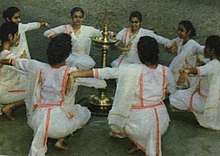
The Knanaya maintain a distinct round dance, the Margamkali, or "the way/path" of Thomas the Apostle. This traditional dance was historically performed widely among Saint Thomas Christians, but the Knanaya have played a prominent role in preserving and maintaining it since European contact. The Margamkali was traditionally a male dance exhibiting twelve players symbolizing the Twelve Apostles dancing in circle around a lighted brass lamp representing Jesus. It is accompanied by ancient songs about Thomas the Apostle, based on the apocryphal 3rd-century text Acts of Thomas. The song text consist of 450 lines, divided into 14 sections. These songs contain Syriac and Tamil diction, suggesting an origin before the emergence of the Malayalam language in Malabar between the 9th and 13th century.[52]
The Margamkali declined considerably after European colonization. In the 17th century, the Knanaya priest Anjilimoottil Itty Thommen Kathanar revised the text, which has influenced its current structure. In 1910, scholar P.U. Luke published the text for the first time in his collection of Ancient Songs.[52] While the dance declined significantly across the St. Thomas Christian community, the Knanaya community have led a revival since the 1970s. Knanaya priest George Karukaparambil and folk culture scholar Chummar Choondal spearheaded research on the Margamkali in the 1970s and '80s with the help of 33 Knanaya ashans (teachers). The team systematized the Margamkali and promoted it among schools and cultural organizations. In 1995, Mar Kuriakose Kunnasserry, the bishop of the Knanaya Diocese of Kottayam, established Hadusa (Syriac for dancing/rejoicing), as an All India Institute of Christian Performing Arts.[14]
Funeral traditions
The Knanaya hold to a death bed tradition based on Old Testament teachings, wherein a dying man gives a final blessing to his children and grandchildren. The father places his hand on the heads of kneeling recipients while giving the invocation.[69] Other funeral traditions include the Thazhukuka, in which friends and relatives embrace a grieving family at a funeral. The family stands in line at the church as the priest sprinkles holy water on them, and friends embrace them. After the burial, the family hold a ceremony at home where they drink from a single tender coconut to symbolize their unity following the death of their loved one.[70]
References
- ↑ Fahlbusch 2008, p. 286.
- 1 2 3 Swiderski 1988b, pp. 55–56.
- ↑ Neill 2004, p. 42.
- ↑ Kollaparambil 1992, pp. 1-20.
- ↑ Kollaparambil 1992, p. 1.
- ↑ Swiderski 1988a, p. 73.
- ↑ Swiderski 1988a, p. 77.
- 1 2 3 Swiderski 1988a, pp. 76–80.
- ↑ Coward 1993, p. 19.
- ↑ Swiderski 1988a, pp. 73–92.
- 1 2 Baum & Winkler 2003, p. 53.
- ↑ Neill 2004, pp. 42–43.
- ↑ Swiderski 1988a, pp. 74–76.
- 1 2 3 4 5 6 7 8 Karukaparambil 2005, p. 497.
- ↑ Karukaparambil 2005, pp. 460-461.
- ↑ Vellian 1990, pp. 25-26.
- ↑ Swiderski 1988b, p. 52.
- ↑ Swiderski 1988b, pp. 63–64.
- ↑ Swiderski 1988b, pp. 65–66.
- ↑ Swiderski 1988b, pp. 66–67.
- ↑ Swiderski 1988a, pp. 76–77.
- ↑ Swiderski 1988a, pp. 77–78.
- 1 2 Swiderski 1988b, pp. 95–96.
- ↑ Swiderski 1988a, pp. 80–82.
- ↑ Vellian 1986, p. 36.
- ↑ Swiderski 1988a, p. 88.
- ↑ Swiderski 1988a, p. 89.
- 1 2 Swiderski 1988a, p. 83.
- ↑ Sharma & Sharma 2004, p. 12.
- ↑ Vellian 1986, p. 2-3.
- 1 2 3 Jussay 2005, p. 30.
- 1 2 Jussay 2005, p. 123.
- ↑ Swiderski 1988a, pp. 77, 83.
- ↑ Vellian 1986, p. 8.
- ↑ Swiderski 1988a, pp. 83–84.
- ↑ Vellian 1986, p. 21-22.
- ↑ Vellian 1986, pp. ii, 22-25.
- ↑ Vellian 1986, pp. 11-13.
- ↑ Vellian 1986, p. 13-20.
- ↑ Vellian 1986, pp. 25-27.
- ↑ Vellian 1986, pp. 32-33.
- ↑ Swiderski 1988a, pp. 84–85.
- ↑ Swiderski 1988a, p. 86.
- 1 2 Swiderski 1988a, p. 87.
- ↑ Swiderski 1988b, p. 169.
- ↑ Jacobsen & Raj 2008, pp. 202–207.
- ↑ Swiderski 1988a, pp. 84–85, 87.
- ↑ Swiderski 1988a, pp. 87–88.
- 1 2 Jussay 2005, pp. 118-128.
- 1 2 Jussay 2005, p. 119.
- ↑ Luke 1911.
- 1 2 3 Vellian 1990, p. 31.
- ↑ Gamliel 2009, pp. 390.
- ↑ Gamliel 2009, pp. 80.
- ↑ Vellian 1990, p. 32.
- 1 2 Jussay 2005, p. 121.
- ↑ Swiderski 1988c, pp. 128–133.
- ↑ Jussay 2005, p. 124.
- ↑ Jussay 2005, p. 125.
- ↑ Alumkalnal 2013, pp. 57-71.
- 1 2 3 Vellian 1990, pp. 25-38.
- 1 2 Vellian 1990, pp. 32-33.
- ↑ Vellian 1990, pp. 33-34.
- ↑ Vellian 1990, pp. 34-35.
- ↑ Vellian 1990, pp. 33-35.
- 1 2 Vellian 1990, p. 35.
- 1 2 3 4 Vellian 1990, pp. 36-37.
- ↑ Vellian 1990, p. 38.
- 1 2 3 4 Vellian 1990, p. 30.
- 1 2 Vellian 1990, p. 28.
- ↑ Vellian 1990, p. 29.
- ↑ Vellian 1990, pp. 28-29.
Bibliography
- Alumkalnal, Sunish (2013). "Pesaha Celebration of Nasranis: A Sociocultural analysis". Journal of Indo-Judaic studies. 13.
- Baum, Wilhelm; Winkler, Dietmar W. (2003). The Church of the East: A Concise History. London-New York: Routledge-Curzon.
- Coward, Harold (1993). Hindu-Christian Dialogue: Perspectives and Encounters. Motilal Banarsidass Publishers. ISBN 978-81-208-1158-4.
- Fahlbusch, Ernst (2008). The Encyclopedia of Christianity: Volume 5. Eerdmans. p. 286. ISBN 9780802824172. Retrieved June 10, 2015.
- Gamliel, Ophira (April 2009). Jewish Malayalam Women's Songs (PDF) (PhD). Hebrew University. Retrieved 2 October 2018.
- Jacobsen, Knut A.; Raj, Selva J. (2008). South Asian Christian Diaspora: Invisible Diaspora in Europe and North America. Ashgate Publishing. ISBN 0754662616. Retrieved 11 September 2012.
- Jussay, P. M. (2005). The Jews of Kerala. Calicut: Publication division, University of Calicut.
- Karukaparambil, George (2005). Marganitha Kynanaitha: Knanaya Pearl. Deepika Book House. ASIN B076GCH274.
- Kollaparambil, Jacob (1992). The Babylonian origin of the Southists among the St. Thomas Christians. Pontifical Oriental Institute. ISBN 8872102898.
- Luke, P.U. (1911). Ancient Songs. Jyothi Book House.
- Neill, Stephen (2004). A History of Christianity in India: The Beginnings to AD 1707. Cambridge University Press. ISBN 0-521-54885-3. Retrieved 8 June 2012.
- Palackal, Joseph J.; Simon, Felix, eds. (2015). "Bar maryam (Son of Mary)". Encyclopedia of Syriac Chants. Christian Musicological Society of India.
- Sharma, Suresh K.; Sharma, Usha (2004). Cultural and Religious Heritage of India: Christianity. Mittal Publications. ISBN 978-81-7099-959-1.
- Swiderski, Richard Michael (1988). "Northists and Southists: A Folklore of Kerala Christians". Asian Folklore Studies. Nanzan University. 47 (1): 73–92. JSTOR 1178253.
- Swiderski, Richard Michael (1988). Blood Weddings: The Knanaya Christians of Kerala. Madras: New Era. Retrieved 8 June 2012.
- Swiderski, Richard Michael (1988). "Oral Text: A South Indian Instance" (PDF). Oral Tradition. 3 (1–2): 129–133. Retrieved 26 July 2014.
- Vellian, Jacob (1990). Crown, Veil, Cross: Marriage Rights. Syrian Church Series. 15. Anita Printers. OCLC 311292786.
- Vellian, Jacob (1986). Symposium on Knanites. Syrian Church Series. 12. Jyothi Book House.
- Weil, Shalva (1982). "Symmetry between Christians and Jews in India: The Cananite Christians and Cochin Jews in Kerala". Contributions to Indian Sociology. 16 (2): 175–196. doi:10.1177/006996678201600202.
External links
| Wikimedia Commons has media related to Knanaya people. |